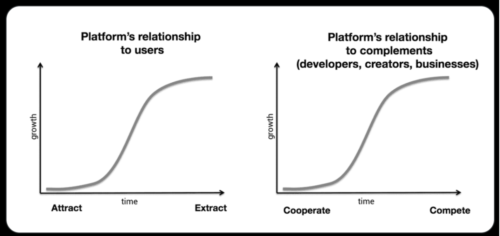It’s probably good to have some clarity on why centralized platforms emerged to begin with, and in my mind the explanation is pretty simple:
- People don’t want to run their own servers, and never will.
- A protocol moves much more slowly than a platform. This isn’t a funding issue. If something is truly decentralized, it becomes very difficult to change, and often remains stuck in time. That is a problem for technology, because the rest of the ecosystem is moving very quickly, and if you don’t keep up you will fail.
…there is nothing particularly “distributed” about the apps themselves: they’re just normal react websites. The “distributedness” refers to where the state and the logic/permissions for updating the state lives: on the blockchain instead of in a “centralized” database.
One thing that has always felt strange to me about the cryptocurrency world is the lack of attention to the client/server interface. When people talk about blockchains, they talk about distributed trust, leaderless consensus, and all the mechanics of how that works, but often gloss over the reality that clients ultimately can’t participate in those mechanics.
With the shift to mobile, we now live firmly in a world of clients and servers – with the former completely unable to act as the latter – and those questions seem more important to me than ever.
This was surprising to me. So much work, energy, and time has gone into creating a trustless distributed consensus mechanism, but virtually all clients that wish to access it do so by simply trusting the outputs from these two companies without any further verification. It also doesn’t seem like the best privacy situation. Imagine if every time you interacted with a website in Chrome, your request first went to Google before being routed to the destination and back. That’s the situation with ethereum today. All write traffic is obviously already public on the blockchain, but these companies also have visibility into almost all read requests from almost all users in almost all dApps.
Instead of storing the data on-chain, NFTs instead contain a URL that points to the data. What surprised me about the standards was that there’s no hash commitment for the data located at the URL. Looking at many of the NFTs on popular marketplaces being sold for tens, hundreds, or millions of dollars, that URL often just points to some VPS running Apache somewhere. Anyone with access to that machine, anyone who buys that domain name in the future, or anyone who compromises that machine can change the image, title, description, etc for the NFT to whatever they’d like at any time (regardless of whether or not they “own” the token). There’s nothing in the NFT spec that tells you what the image “should” be, or even allows you to confirm whether something is the “correct” image.
I think this is very similar to the situation with email. I can run my own mail server, but it doesn’t functionally matter for privacy, censorship resistance, or control – because GMail is going to be on the other end of every email that I send or receive anyway. Once a distributed ecosystem centralizes around a platform for convenience, it becomes the worst of both worlds: centralized control, but still distributed enough to become mired in time. I can build my own NFT marketplace, but it doesn’t offer any additional control if OpenSea mediates the view of all NFTs in the wallets people use (and every other app in the ecosystem).
If we do want to change our relationship to technology, I think we’d have to do it intentionally. My basic thoughts are roughly:
- We should accept the premise that people will not run their own servers by designing systems that can distribute trust without having to distribute infrastructure.
- We should try to reduce the burden of building software.

